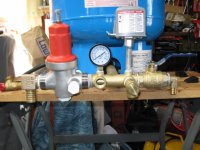Tenaya
New Member
Hi,
I have a well and water system suffering from what seems to me to be a substantial water hammer. The well was drilled and the motor/pump installed in mid-2015. The house plumbing was completed in late 2016.
Here are some specifics:
The problem I have is a substantial water hammer when the pump starts, followed by another hammer when the pump stops. I retrofitted the well control box with indicator lights for power and pump running. If I put my hand on the exposed PEX from the well, I can feel a sizeable jolt and loud thump when the pressure switch clicks and the pump running light illuminates. When the pressure hits the upper limit and switch clicks again, the pump running light goes out and I feel an equal sized jolt. If I do this with my hand on the PEX that runs from the well tee to the filter or the filter into the house, the thumps sound, but there are essentially no jolts.
We noticed this issue after we moved in (late 2018), but life got in the way of dealing with it before now. Since we don't want the driller and/or plumbing contractor coming to the house during the pandemic (we're in our 70's). I'd like to see if I can remedy the issue myself.
Despite the good reputations of the driller and plumber, I suspect a system design problem, especially with the relative newness of the various components. I've read that having check valves at BOTH the wellhead and the pressure tank can sometimes cause water hammer. I've also read about installing a soft start control. I've read about cycle stop valves, but I don't really understand them.
Can anyone suggest a solution to this issue, preferably one a fairly handy non-professional can implement at a reasonable cost?
Thank you in advance,
Tenaya
I have a well and water system suffering from what seems to me to be a substantial water hammer. The well was drilled and the motor/pump installed in mid-2015. The house plumbing was completed in late 2016.
Here are some specifics:
- The well was drilled 9" to 287', cased 5" PVC solid to 222', 5" perforated PVC to 282' and cemented to 22'. I'm told this is pretty standard for a single family residence in my area (Texas Panhandle)
- The static water level is 200' and the yield was reported to be 18gpm with 0 drawdown after 1hr.
- The pump is a "J-Class" submersible from Franklin Electric. I haven't been able to determine the precise model number because none of the numbers on the installation record seem to match model numbers on the Franklin website.
- The installation record mentions a check valve at the wellhead, but doesn't specify its rating. I haven't opened it to lay eyes on it.
- The motor is 220v single phase, wired with 265' of 10/4.
- In the garage utility closet, the pump wiring was brought to a Franklin Electric well control box.
- The control box is wired to a Square D PumpTrol pressure switch, set to 55/65 psi.
- The well is plumbed to a FlexLite FL30 90 gallon pressure tank through a brass well tee.
- The well tee is then plumbed to the house through a TwistIIClean particulate filter with a 100 mesh (150 micron) screen.
- Additionally, the well tee has a hose bib for draining the tank and a 75psi check valve.
- The entire house is plumbed with PEX (crimp rings, not SharkBite), including the 1" run from the wellhead to the well tee, with brass valves and fittings.
The problem I have is a substantial water hammer when the pump starts, followed by another hammer when the pump stops. I retrofitted the well control box with indicator lights for power and pump running. If I put my hand on the exposed PEX from the well, I can feel a sizeable jolt and loud thump when the pressure switch clicks and the pump running light illuminates. When the pressure hits the upper limit and switch clicks again, the pump running light goes out and I feel an equal sized jolt. If I do this with my hand on the PEX that runs from the well tee to the filter or the filter into the house, the thumps sound, but there are essentially no jolts.
We noticed this issue after we moved in (late 2018), but life got in the way of dealing with it before now. Since we don't want the driller and/or plumbing contractor coming to the house during the pandemic (we're in our 70's). I'd like to see if I can remedy the issue myself.
Despite the good reputations of the driller and plumber, I suspect a system design problem, especially with the relative newness of the various components. I've read that having check valves at BOTH the wellhead and the pressure tank can sometimes cause water hammer. I've also read about installing a soft start control. I've read about cycle stop valves, but I don't really understand them.
Can anyone suggest a solution to this issue, preferably one a fairly handy non-professional can implement at a reasonable cost?
Thank you in advance,
Tenaya



